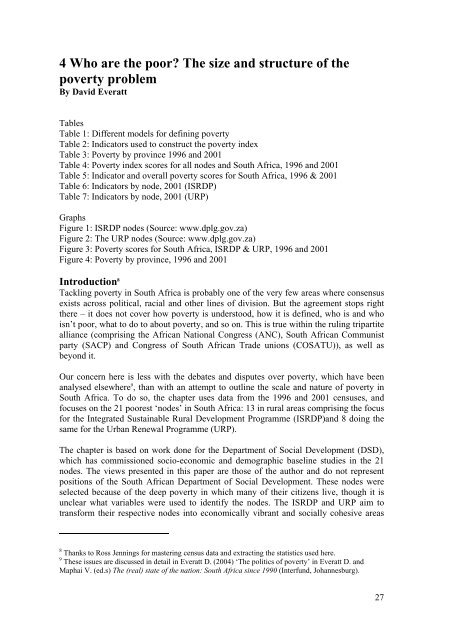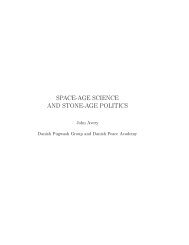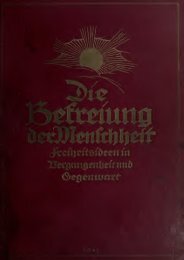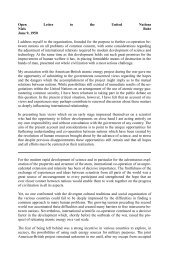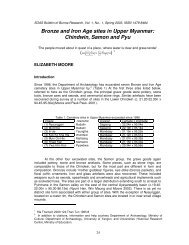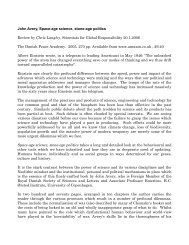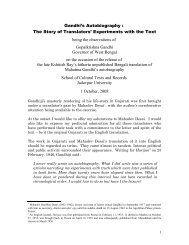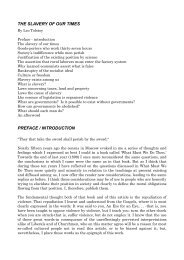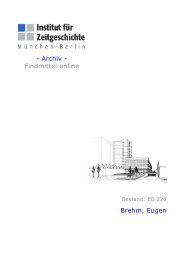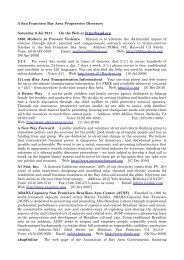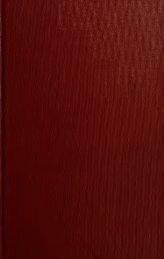History in the new South Africa: an introduction - Det danske ...
History in the new South Africa: an introduction - Det danske ...
History in the new South Africa: an introduction - Det danske ...
Create successful ePaper yourself
Turn your PDF publications into a flip-book with our unique Google optimized e-Paper software.
4 Who are <strong>the</strong> poor? The size <strong>an</strong>d structure of <strong>the</strong><br />
poverty problem<br />
By David Everatt<br />
Tables<br />
Table 1: Different models for def<strong>in</strong><strong>in</strong>g poverty<br />
Table 2: Indicators used to construct <strong>the</strong> poverty <strong>in</strong>dex<br />
Table 3: Poverty by prov<strong>in</strong>ce 1996 <strong>an</strong>d 2001<br />
Table 4: Poverty <strong>in</strong>dex scores for all nodes <strong>an</strong>d <strong>South</strong> <strong>Africa</strong>, 1996 <strong>an</strong>d 2001<br />
Table 5: Indicator <strong>an</strong>d overall poverty scores for <strong>South</strong> <strong>Africa</strong>, 1996 & 2001<br />
Table 6: Indicators by node, 2001 (ISRDP)<br />
Table 7: Indicators by node, 2001 (URP)<br />
Graphs<br />
Figure 1: ISRDP nodes (Source: www.dplg.gov.za)<br />
Figure 2: The URP nodes (Source: www.dplg.gov.za)<br />
Figure 3: Poverty scores for <strong>South</strong> <strong>Africa</strong>, ISRDP & URP, 1996 <strong>an</strong>d 2001<br />
Figure 4: Poverty by prov<strong>in</strong>ce, 1996 <strong>an</strong>d 2001<br />
Introduction 8<br />
Tackl<strong>in</strong>g poverty <strong>in</strong> <strong>South</strong> <strong>Africa</strong> is probably one of <strong>the</strong> very few areas where consensus<br />
exists across political, racial <strong>an</strong>d o<strong>the</strong>r l<strong>in</strong>es of division. But <strong>the</strong> agreement stops right<br />
<strong>the</strong>re – it does not cover how poverty is understood, how it is def<strong>in</strong>ed, who is <strong>an</strong>d who<br />
isn’t poor, what to do to about poverty, <strong>an</strong>d so on. This is true with<strong>in</strong> <strong>the</strong> rul<strong>in</strong>g tripartite<br />
alli<strong>an</strong>ce (compris<strong>in</strong>g <strong>the</strong> <strong>Africa</strong>n National Congress (ANC), <strong>South</strong> <strong>Africa</strong>n Communist<br />
party (SACP) <strong>an</strong>d Congress of <strong>South</strong> <strong>Africa</strong>n Trade unions (COSATU)), as well as<br />
beyond it.<br />
Our concern here is less with <strong>the</strong> debates <strong>an</strong>d disputes over poverty, which have been<br />
<strong>an</strong>alysed elsewhere 9 , th<strong>an</strong> with <strong>an</strong> attempt to outl<strong>in</strong>e <strong>the</strong> scale <strong>an</strong>d nature of poverty <strong>in</strong><br />
<strong>South</strong> <strong>Africa</strong>. To do so, <strong>the</strong> chapter uses data from <strong>the</strong> 1996 <strong>an</strong>d 2001 censuses, <strong>an</strong>d<br />
focuses on <strong>the</strong> 21 poorest ‘nodes’ <strong>in</strong> <strong>South</strong> <strong>Africa</strong>: 13 <strong>in</strong> rural areas compris<strong>in</strong>g <strong>the</strong> focus<br />
for <strong>the</strong> Integrated Susta<strong>in</strong>able Rural Development Programme (ISRDP)<strong>an</strong>d 8 do<strong>in</strong>g <strong>the</strong><br />
same for <strong>the</strong> Urb<strong>an</strong> Re<strong>new</strong>al Programme (URP).<br />
The chapter is based on work done for <strong>the</strong> Department of Social Development (DSD),<br />
which has commissioned socio-economic <strong>an</strong>d demographic basel<strong>in</strong>e studies <strong>in</strong> <strong>the</strong> 21<br />
nodes. The views presented <strong>in</strong> this paper are those of <strong>the</strong> author <strong>an</strong>d do not represent<br />
positions of <strong>the</strong> <strong>South</strong> <strong>Africa</strong>n Department of Social Development. These nodes were<br />
selected because of <strong>the</strong> deep poverty <strong>in</strong> which m<strong>an</strong>y of <strong>the</strong>ir citizens live, though it is<br />
unclear what variables were used to identify <strong>the</strong> nodes. The ISRDP <strong>an</strong>d URP aim to<br />
tr<strong>an</strong>sform <strong>the</strong>ir respective nodes <strong>in</strong>to economically vibr<strong>an</strong>t <strong>an</strong>d socially cohesive areas<br />
8 Th<strong>an</strong>ks to Ross Jenn<strong>in</strong>gs for master<strong>in</strong>g census data <strong>an</strong>d extract<strong>in</strong>g <strong>the</strong> statistics used here.<br />
9 These issues are discussed <strong>in</strong> detail <strong>in</strong> Everatt D. (2004) ‘The politics of poverty’ <strong>in</strong> Everatt D. <strong>an</strong>d<br />
Maphai V. (ed.s) The (real) state of <strong>the</strong> nation: <strong>South</strong> <strong>Africa</strong> s<strong>in</strong>ce 1990 (Interfund, Joh<strong>an</strong>nesburg).<br />
27


